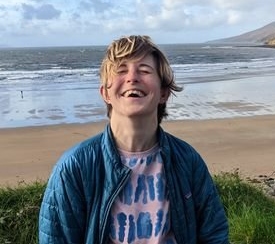The outdoors doesn’t discriminate. It’s a narrative we hear often, particularly in adventure media. But the truth is that not all open spaces are open to everyone. With cliffs, human-made ocean defences or sometimes straight-up nonsensical infrastructure, accessing the sea can prove particularly problematic. Para athlete Hannah Dines explores the challenges of disabled access on our coastlines.
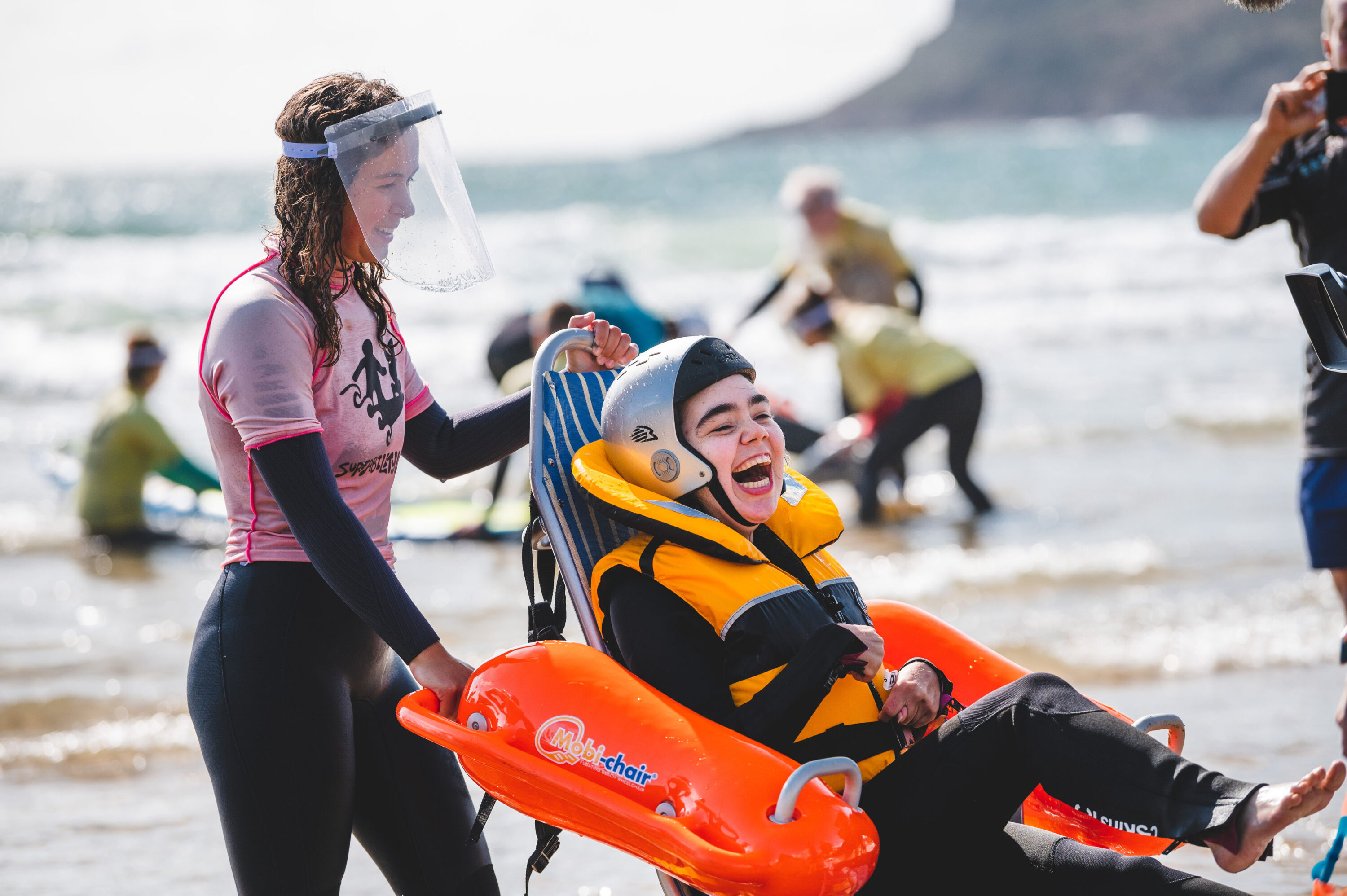
Surfability UK CIC volunteer pushes Kai across Caswell using the Mobi-Chair
Full disclosure: I’m trying to become the UK’s first female prone surfing World Champion. So, this article, mostly written in desperation, is written from the perspective of a girl with cerebral palsy who has driven around almost every coast, trying to access the surf.
My cerebral palsy affects all of the muscles in my body and, as an added bonus, my balance. On uneven terrain I often fall. All parts of your average coastline are barriers: rocky beaches, soft sand, hills and the distance between car park and shoreline too. To be fair, I have been known to fall on perfectly flat concrete. It’s why I love water, even the washing machine spin cycle in huge waves is preferable to skin-ripping tarmac. Still, I use a car or mobility scooter to prevent constant bodily harm. Most mobility aids are not made with sand in mind, just like my scooter. So, when I am not with a fully equipped surf school, accessing the coast in the UK means I’m left to look on from the nearest tarmac path.
I used to be a Paralympic trike racer and I’d get a lot of time in green spaces training, if they had roads through them. I would often stop and look up into leaf canopies, hug trees, bury my face in grass. Blue spaces were something I only saw from afar and which I longed for. Looking back, there’s a certain part of my brain that has needed water all along.
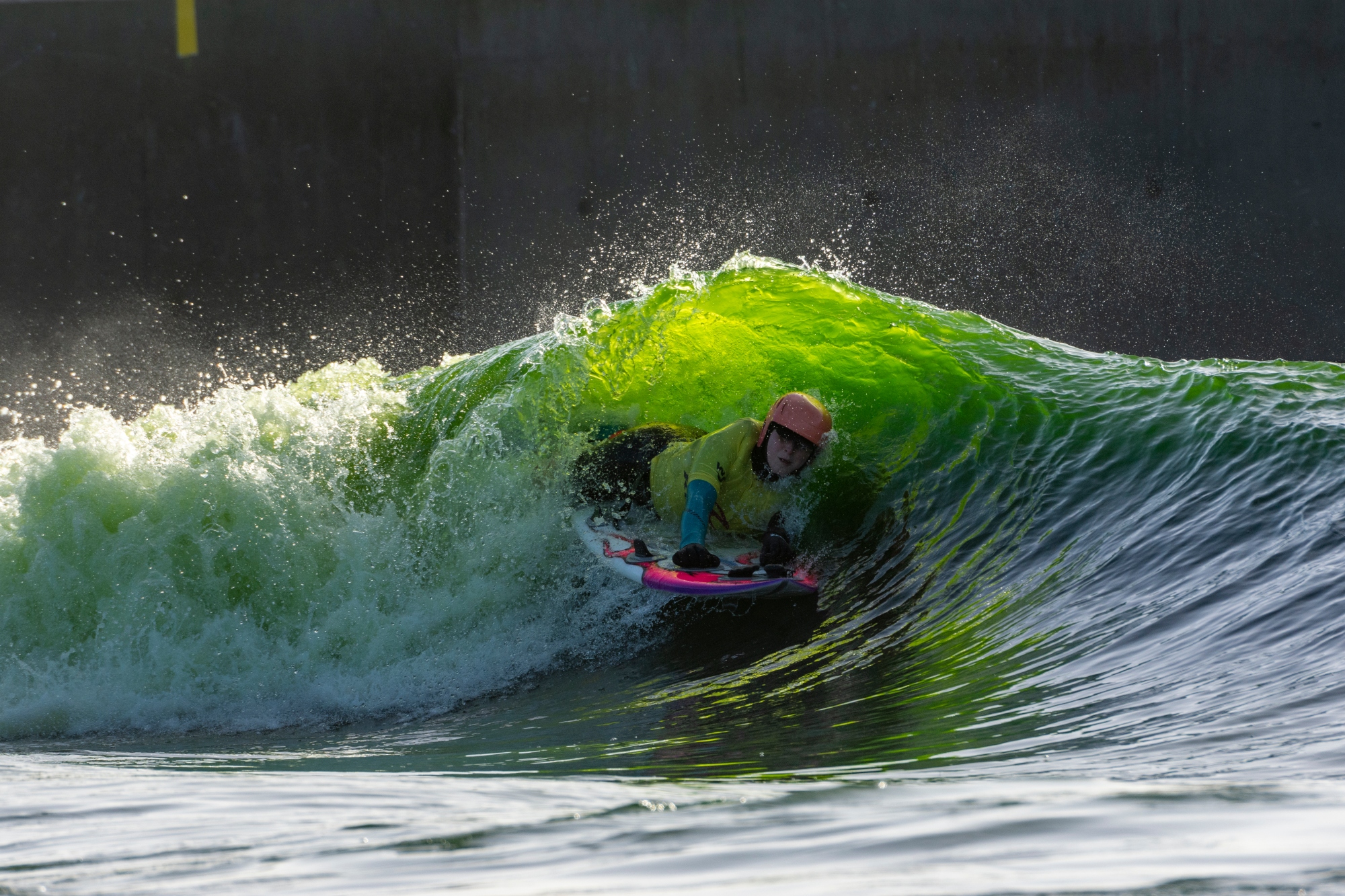
Author Hannah Dines tucks into the pocket at The Wave in Bristol. © Rob Tibbles / Surfing England
Once, I got in trouble at a Cycling World Cup by the Belgian coastline in Ostend. I felt this need to be at sea, free of the strict competition environment. Myself and another wobbly trike racer plotted together and decided to hold each other up to make it over the sand to touch the water. The British team watched, all together, from the glass-panelled hotel and apparently gasped at how often we almost fell, how strenuous it was. We decided it was too hard and turned back half way. Still, I was severely reprimanded for exhausting myself before a major race. It wasn’t even twenty metres. Barely more metric distance than my age at the time. Really, we were just holding hands and trying to have a romantic walk on the beach, feel the ocean and escape with each other.
Would it have been different if there had been beach matting there, as standard? Beach mats are cheap, foldable, portable mats that allow individuals with existing mobility equipment to access the beach themselves with their own kit and also make walking much easier.
Support in the sea isn’t so rare anymore, thanks to initiatives from Surfability UK and SurfABLE Scotland; the only full-time, adaptive surf schools in Europe. Surfability, the surf-school who taught me to surf and that I train with most, run courses in best practice for existing surf coaches to support adaptive surfing at their existing schools. There’s The Wave Project too – often mistaken for the same thing but is a charity set up to provide wave therapy for vulnerable children and young people, who may or may not be disabled.
Even the washing machine spin cycle in huge waves is preferable to skin-ripping tarmac
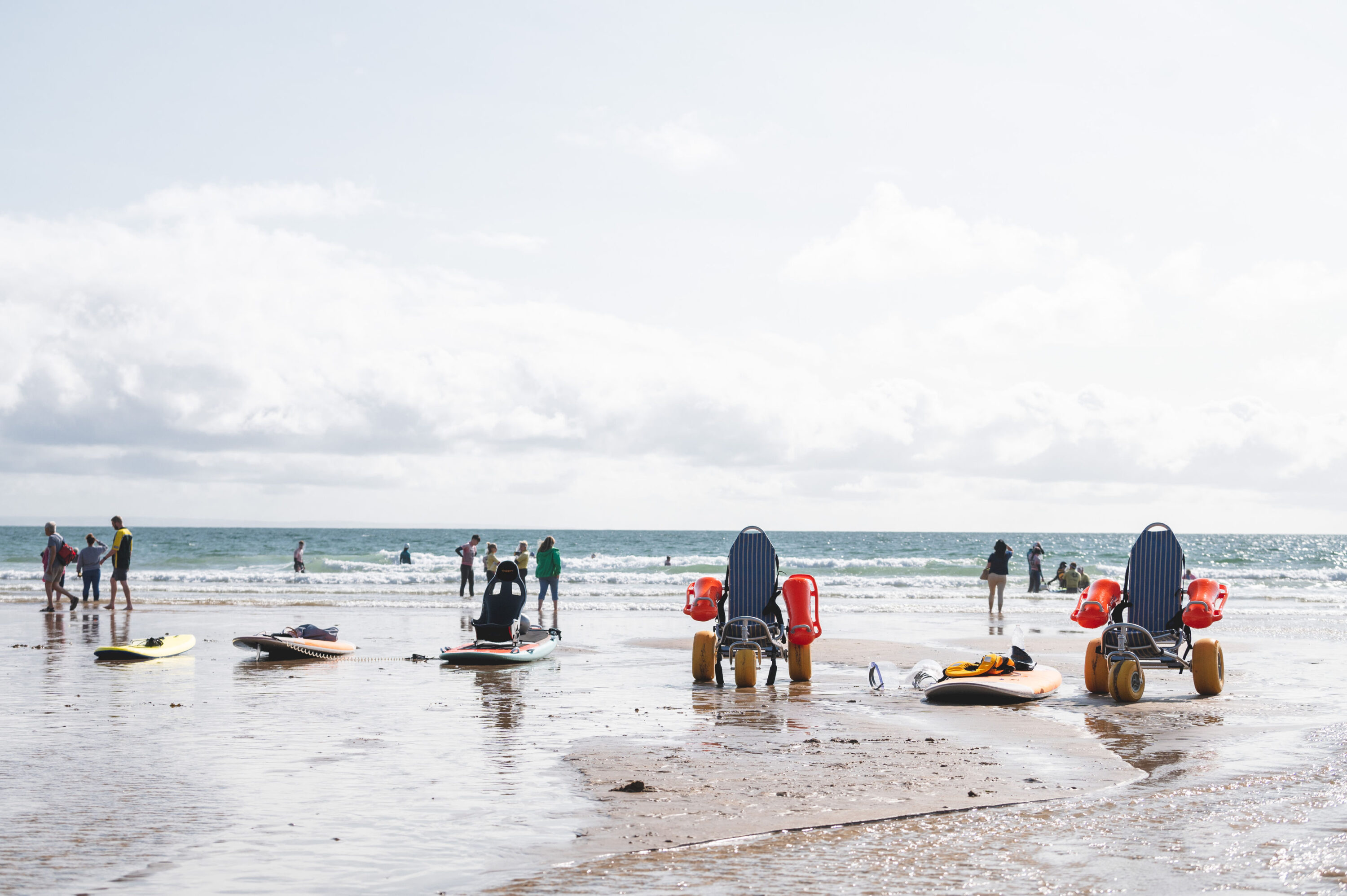
Adaptive surf and beach craft at Surfability UK H, Caswell Bay, South Wales.
To self-direct, to set one’s eye on a distant point and be able to get there, is one thing I will never take for granted
It was Surfability UK on the Gower Peninsula who took me in, when I phoned, desperate to surf. I managed to get through to head coach Ben’s personal number and speak to him. He said I could come down and stay as long as I needed. Now, at the school it’s the stuff of lore that I van-camped for two months with a gap to travel to Hopeman in the Highlands with SurfABLE, and then went back to South Wales and surfed again and again, never sated. It had everything, the accessible hot shower, wheelchairs to access the sea and adapted boards.
To me, a sea-change is visible. Some standard surf schools and The Wave, Bristol’s wave pool, have bought off-the-shelf prone boards made by Flowt (before you would have had to adapt your own) and have coaches who have been trained in the art of water assistance. Several master shapers, JP and Skindog, regularly make adapted competition boards. Deck grip is also paving its adapted grippy way, through Surfdek with adapted handles and leg fenders which stick to deckside rails and stop leg slip.
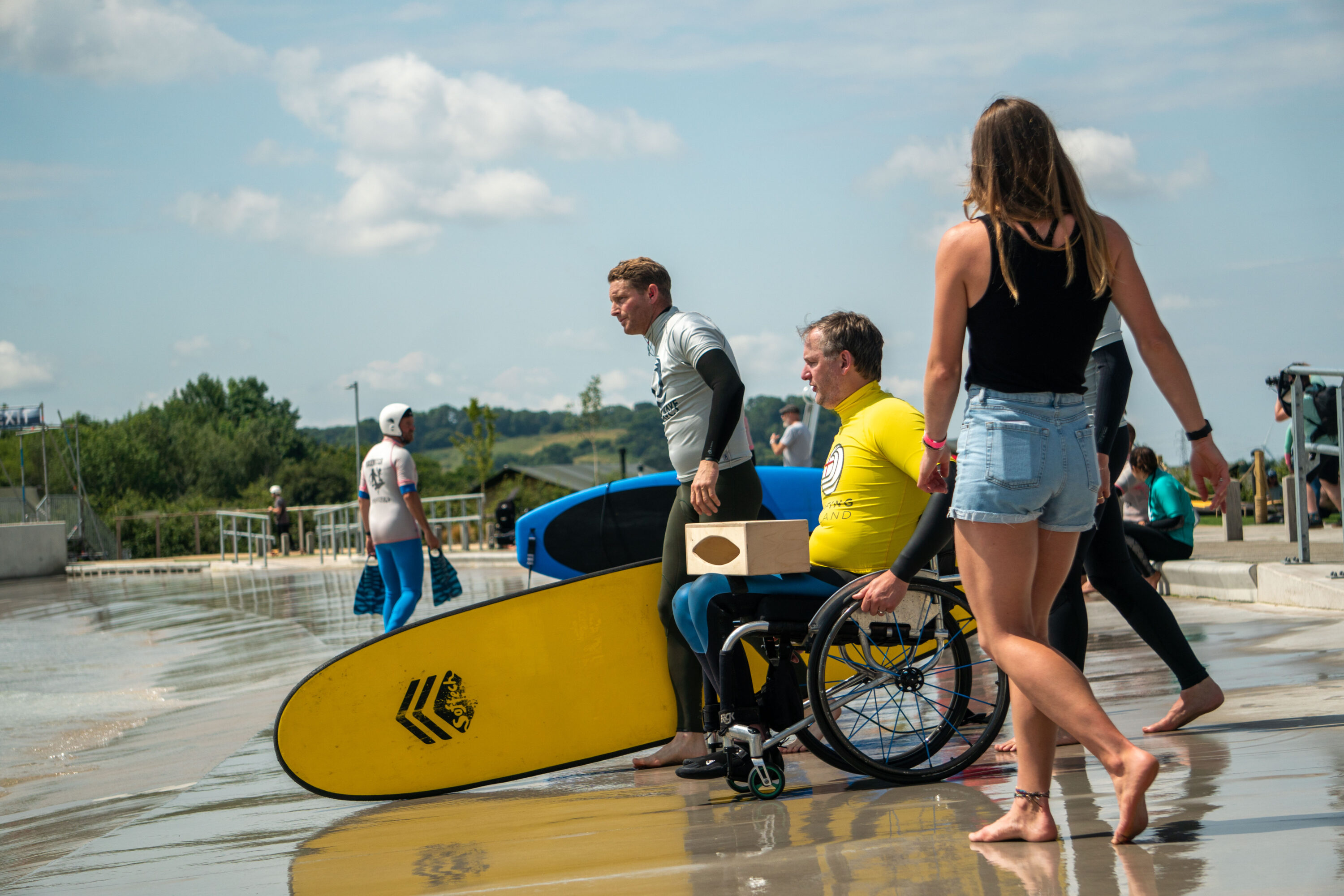
Surfers prepare to go in the water at English Adaptive Surfing Open at The Wave © Surfing England
With the schools, pools and coaches primed and ready to offer adaptive surf coaching, one last bastion stands in the way of me and others with a range of mobility impairments. Other schools offer adaptive surfing opportunities but almost none operate from beaches with beach matting or wheelchairs: not Newquay, Constantine, Bournemouth, Scarborough, Whitby, Croyde, or Pease Bay. On these trips I have needed huge amounts of help walking and it takes about half the session to haul me in and out of the sea. Now almost a decade older, I know British Cycling was right. Oh for the swift beach wheelchair wheels at Surfability surf school who understand that preventing pain and energy expenditure is as important as good surf instruction, so I can surf well, at full power.
But an important point to note is that these beach wheelchairs are not self-propelled. Their use assumes company in the way of assistants able to push them. But as a young, disabled, solo-adventurer, for me this is not the case.
Even with all the adapted surf coaches in the world at Surfability headquarters, I want to move myself and my board. Oh to be a lifeguard with rippling abs, bare-foot and running with surfboard under arm to jump over the spray and let the swell take me. To self-direct, to set one’s eye on a distant point and be able to get there, is one thing I will never take for granted. Not least on the way back up from Caswell Bay, because there’s an incredibly steep ramp and my rippling-abbed surf instructor has just been treading water and taking waves on the head with me for hours.
While electric models are heavier than life itself and won’t give you lifeguard abs, they do enable you to zoom down the beach under the steam of a sand and salt proof lithium battery, with surfboard attached to a homemade rack on the side. If I had a ramp-entry van and a significant lottery win, I’d invest in an electric chair in an instant.
So, those beach mats and beach chairs are one thing, but the gold standard, in my opinion, has to be what Bruno Hansen has constructed. Danish by way of South Africa he’s a world champion surfer, and spends his time between Bali and Cornwall. In Bali, he can take a quad bike on the beach and he welded a side-car to it for his wheelchair (he’s paralysed from the waist down but that’s beside the point, except that he has those rippling abs I was talking about). In the UK and Cornwall, there is no beach mobility and no quads allowed, so the master engineer that he is, he built the Bruno Beach Beast.
Taking tank treads from some kind of old all-terrain wheelbarrow, he welded them to a 200cc lawn mower engine, moving all the controls to hand height; he bent steel tubing into a board rack and built a base for a tractor seat, creating the ultimate go-anywhere wheelchair, ready for any beach on the planet. ‘No beach too big!’ he says, unable to mask a grin as he beams like a big old sunshine.
The Best of Beach Wheelchairs
01 Mobi-chair
COMFORT 5/5
GETTING IN AND OUT 5/5
STORAGE 1/5
ALL TERRAIN 2/5
This looks like a deck chair with wheels and huge orange arm rests. It also feels like a deckchair. Its height means that it’s easier to self-transfer into. It fits people of all sizes and is by far the comfiest. It also comes with the perks that it floats on water but my surf school, who use manual slings to support the highest support needs individuals into their seated tandem, would rather it sunk and stayed stable.
02 Landeeze
COMFORT 5/5
GETTING IN AND OUT 4/5
STORAGE 3/5
ALL TERRAIN 5/5
I’ve gone down a flight of steps in this chair. The suspension of the wheels is insane. I’d call it a bouncemobile. I believe the company also offers conversion kits so you can convert an old wheelchair. The wheelchair it comes with is not as easy access, for me at least, but it’s got the standard lift arm at the side entry.
03 Hippocampe
COMFORT 2/5
GETTING IN AND OUT 1/5
STORAGE 5/5
ALL TERRAIN 3/5
This is the most adaptable for high support needs individuals but the extra components don’t come as standard. You can ensure a head and body is entirely cradled and stable if you need. However, the most basic frame is both very low to the ground and has no safety features, without a defined space for feet or arms. For this reason it is hardest for me to get into. It is the most portable and most easily stored with its slim frame, even if its wheels are as big as the rest of the three-wheeled profile. It could also manage steep slopes and has a pulley rope on the front.
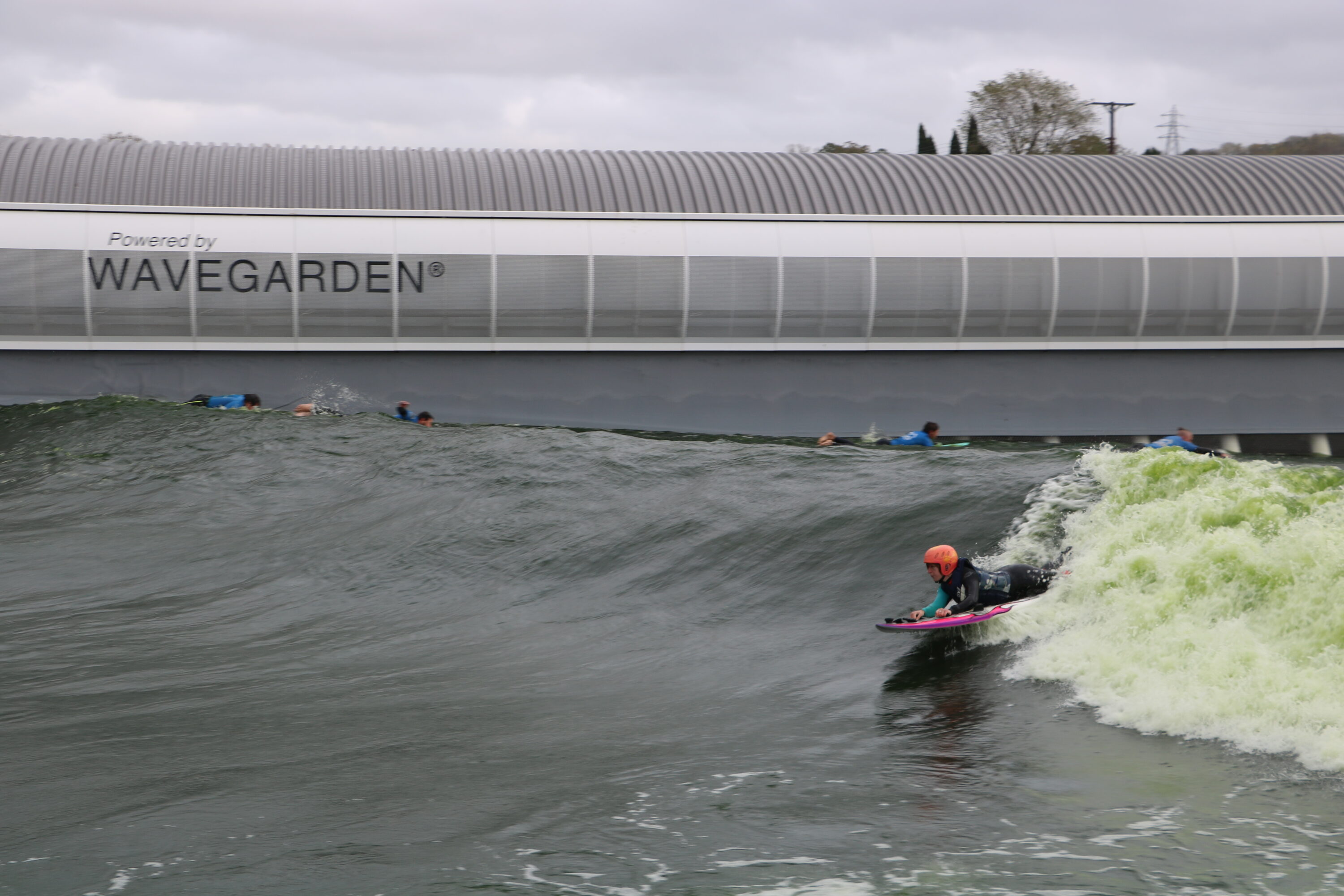
Hannah lining up a long open face at The Wave in Bristol. © Russell Field / Surfdek
While we can all revel in engineering mastery, why must Bruno spend weeks in a workshop just to access a public space? My surf school is incredible but it segregates me to my one beach on this huge, blue planet. My surfing is about being tossed into the unknown. A lot of the time it is about being forced to let go, pummelled into this calm oblivion where panic never surfaces. In my favourite big swells there’s a brief sensory overload, waves in the eyes, ears, nose and mouth, sunshine searing eyes and then nothing but gentle swishing as the wave takes my rail and delivers me to shores anew. However fanciful this imagery, surfing takes me to a place where the weight of the world does not exist. The sea does not discriminate.
To a disabled kid or newly disabled adult, that blue horizon shrinks down to almost nothing, unless of course they live by Caswell Bay or near Hopeman where the adaptive surf schools are. If we made beach matting as common as say the lifebuoys we see by the coast, rivers and on harbours, how many could we save from tarmac and monotony? How many could we teach that they belong in these places and how many new ways of doing things could we be taught? We must make coastlines free to all, with public investment in existing or homemade beach accessibility options.
This story first appeared in issue 09 of BASE magazine. Subscribe for FREE to make sure you’re among the first to read every issue.
Don’t miss a single adventure
Sign up to our free newsletter and get a weekly BASE hit to your inbox
You might also like
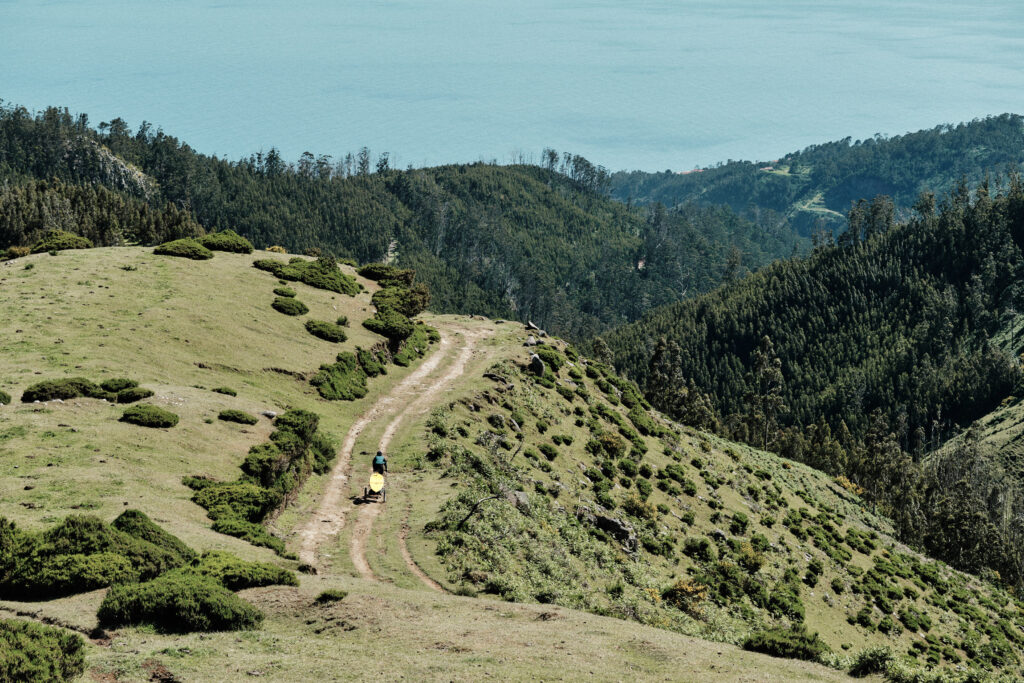
Story • Sami Sauri • Jul 13, 2022
32 Degrees North: Bikes and Waves on Maderia
Sami Sauri explores the best of this Atlantic island by bike and surfboard
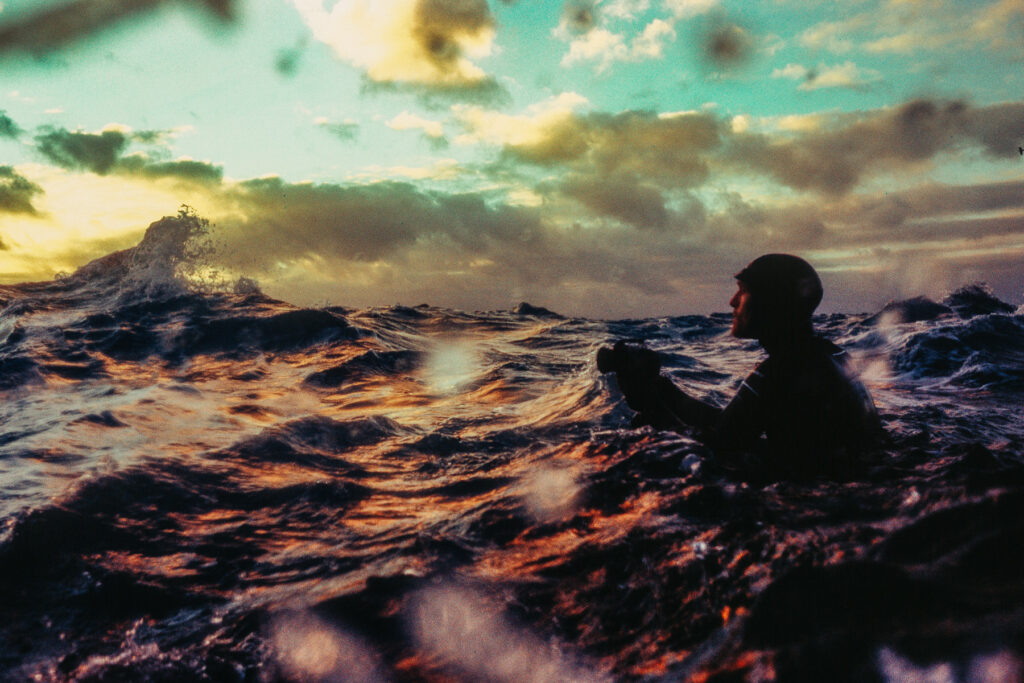
Video • BASE editorial team • Mar 11, 2022
Recollections in Atlantic Reverie
A lifetime of human hearts bewitched by the sea
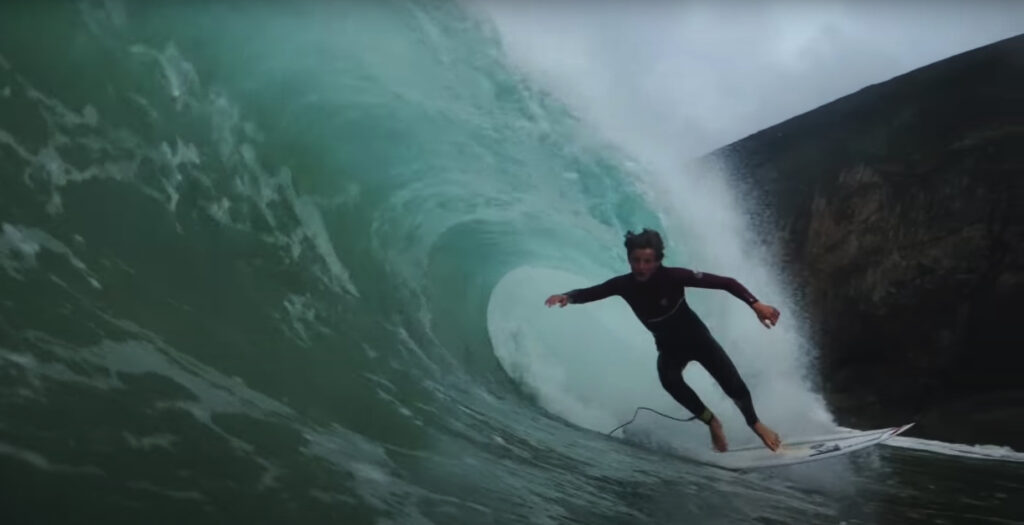
Video • BASE editorial team • Feb 15, 2022
Concrete Is Harder Than Water
A short film about Lukas Skinner and his road to repair
